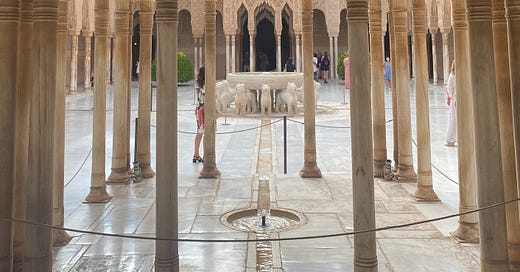My dearest Global Jigsaw,
It would be fabulous if you decide that today is the day to finally become a paid subscriber of this newsletter! If not, I am sure it will be a fabulous day in other ways. So all I really ask is for you to read on:
To be territorially polygamous, as I have been, is to have inculcated a sense of capaciousness that expands the idea of “home.” The more one travels, the more one discovers how political borders obscure fundamental truths. For as much as we try and match national narratives to the tidy geometry of maps, our histories have in fact been messy, cross-pollinated and multiple.
The result is the constant shock of recognition. There is always something of what you consider to be your own, in even the most “foreign” of lands. China, for example – a country I lived in for almost a decade - was no longer inscrutable once I’d discovered that strangers addressed each other as family: auntie, grandmother, older brother. Rural folk shared their boiled eggs and oranges with me on cross-country bus journeys, reminiscent of similar trips in India.
In Indonesia, references to the Hindu epics of the Ramayana and Mahabharata are embedded in the language, on street hoardings and political commentary. When I lived in Jakarta (between 2012-2016), my local mechanic was called Rama Repairs and my neighbourhood shopping mall was Dharmawangsa Square. I came across a nation-wide charitable foundation for twins called the Nakula and Sadewa society, and a support group for Indonesian women in mixed marriages named Srikandi (Shikhandi).
The examples I’ve given so far are from Asia, but even in faraway Spain, the country I now call home, there is much that instantly feels mine.
Both Spaniards and Indians are unguarded physically, unselfconsciously loud, and terminally social. And beyond personality traits, we share an Islamic heritage, so that many of the jewels of our “national” patrimony are architectural siblings. The echoes of the geometric effervescence of the Alhambra in Spain’s Granada are loud in any of the great forts and palaces of the Indian Mughals.
Pic: The Alhambra in Granada. Credit: Pallavi Aiyar
Then there is the language. Ojala, which means “hopefully” in Spanish, has its root in insh’allah. So that every time a Spaniard says something akin to, “Hopefully we’ll meet soon,”, they are etymologically invoking the grace of God (Allah).
Modern Spanish has thousands of words with Arab roots, linking it in a string of lexical pearls to Hindi/Hindustani, given the latter’s debt to Persian-mediated Arabic. Consider the words for sugar: azúcar in Spanish derives from the Mozarabic (Arabic influenced Spanish that developed between the 7th and 15th centuries) assúkar, in turn from the classical Arabic sukkar. In Hindustani it is shakkar.
Or the words for chess: Ajedrez in Spanish comes from the Mozarabic aššaṭran, which has its root in the classical Arabic, šiṭranǧ. In Hindustani it is shatranj.
There is more. The most iconic demographic of the country - the gitanos or gypsies - identify strongly with India, the land that they trace their origins to. I realized this upon finding myself in a cinch with a Gypsy flamenco singer in a smoky tavern in Madrid. I’d been only one amongst the musician’s many adoring fans until he learned that I was Indian. “I am from India too,” he’d said, tapping his chest with an open palm before gathering me up for a hug.
An India friend and I channeling our inner gitanas and practicing flamenco in the Spanish countryside (my boys doing the monkey in the backfround)
Gitanos, of which there are upwards of 750,000 in Spain, do not have a well-documented history. But they are believed to have entered the region during the 15th century. Linguistic analysis of Romani (gypsy) dialects shows that they originated in northwestern India and migrated westwards in waves, between 300 BC and AD 600.
The language of Spanish gypsies is called caló and some Spanish sources refer to the people as calé referring to their darker skin, since in caló, calé means black. The “c” is hard, so the word is pronounced kale. Sound familiar?
One of the most delicious stories of Indo-Spanish linguistic connect, courtesy the gitanos, has to do with the spicy sausage so emblematic of Spain: the chorizo. The word in Spanish not only refers to the cold cut, but is also slang for a thief, deriving from the caló term chori for thief. Which explains how India’s chors became chorizos in Spain.
What this whirl around the world demonstrates is that culture isn’t static. It can slip through cracks, heedless of walls and borders. Us and them is a deceptive dichotomy, something that travelers have been aware of for long. The philosopher Democritus of Abdera had it right all the way back in 420BC when he said, “To a wise man, the whole earth is open; for the native land of a good soul is the whole earth.”
The high priests of cultural warfare – the inquisition/ the ayatollahs/the prophets – have always been tempted by neatness. But as humans we are unruly. We strain to escape our straightjackets, to bend and entwine. Great science, literature, food – indeed great love – exists on the intersections of, and in the crossings of policed boundaries.
xoxo
That’s all for this week. Hope you are all well and reading interesting things. Do share recommendations and let me know if anyone has an idea that they might like to write a guest post about for The Global Jigsaw. I would love to feature some new voices.
My best until next week,
Pallavi





Very interesting....For me this realization dawned when I looked at how similar the Italian for numbers 6-10 (sei, sette, otto, novo, dieci) is to Hindi (cheh, saath, aath, nau and dus).
Fascinating stuff! The chor-chorizo trivia is delicious.